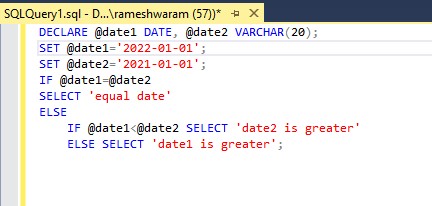In SQL databases, handling dates is a fundamental task. Whether you’re filtering records, generating reports, or managing time-sensitive data, comparing dates accurately is crucial. This guide will walk you through the essentials of comparing dates in SQL, using straightforward examples to illustrate key concepts.
Understanding how to effectively compare dates in SQL is essential for anyone working with databases. SQL provides simple yet powerful methods to perform these comparisons, allowing you to extract meaningful insights from your date-related data. We’ll explore how to use standard comparison operators and conditional statements to achieve precise date comparisons in your SQL queries.
SQL Date Datatypes: Setting the Stage for Comparison
Before diving into comparisons, it’s important to understand the common date datatypes in SQL. The primary datatype for storing dates is DATE, which typically stores year, month, and day. Many databases also offer DATETIME or TIMESTAMP datatypes, which extend DATE to include time components (hours, minutes, seconds, and sometimes milliseconds or time zones).
When comparing dates, ensure you are comparing compatible datatypes. While SQL often handles implicit conversions, it’s best practice to be explicit, especially when dealing with strings that represent dates.
Basic Date Comparison Operators in SQL
SQL utilizes standard comparison operators to compare dates, just as you would compare numbers or strings. These operators include:
=(Equals): Checks if two dates are the same.<(Less Than): Checks if the first date is earlier than the second date.>(Greater Than): Checks if the first date is later than the second date.<=(Less Than or Equal To): Checks if the first date is earlier than or the same as the second date.>=(Greater Than or Equal To): Checks if the first date is later than or the same as the second date.<>or!=(Not Equal): Checks if two dates are different.
These operators are used directly in your WHERE clauses to filter data based on date criteria, or within conditional logic like IF-ELSE statements.
Comparing Dates Using IF-ELSE Statements
For more complex logic, especially within stored procedures or scripts, you can use IF-ELSE statements to compare dates and execute different SQL code blocks based on the comparison result.
The basic syntax of an IF-ELSE statement in SQL is:
IF Boolean_expression
BEGIN
-- SQL statement(s) to execute if Boolean_expression is true
END
ELSE
BEGIN
-- SQL statement(s) to execute if Boolean_expression is false
END;To compare dates within an IF-ELSE block, you would replace Boolean_expression with a date comparison using the operators mentioned earlier. Let’s illustrate with examples.
Example 1: Comparing Two Dates for Equality
This example declares two date variables, @date1 and @date2, and uses an IF-ELSE statement to check if they are equal.
DECLARE @date1 DATE, @date2 DATE;
SET @date1 = '2021-01-01';
SET @date2 = '2021-02-02';
IF @date1 = @date2
BEGIN
SELECT 'Equal dates';
END
ELSE IF @date1 < @date2
BEGIN
SELECT 'date2 is greater';
END
ELSE
BEGIN
SELECT 'date1 is greater';
END;Output:
In this case, since ‘2021-01-01’ is not equal to ‘2021-02-02’ and is indeed less than it, the output correctly indicates “date2 is greater”.
Example 2: Comparing Date with VARCHAR
It’s important to note that SQL can often compare a DATE datatype with a string (VARCHAR) that is in a valid date format.
DECLARE @date1 DATE, @date2 VARCHAR(20);
SET @date1 = '2021-01-01';
SET @date2 = '2021-01-01';
IF @date1 = @date2
BEGIN
SELECT 'Equal dates';
END
ELSE IF @date1 < @date2
BEGIN
SELECT 'date2 is greater';
END
ELSE
BEGIN
SELECT 'date1 is greater';
END;Output:
Here, even though @date2 is a VARCHAR, SQL implicitly converts it to a DATE for the comparison, and because both dates are ‘2021-01-01’, the output correctly shows “Equal dates”.
Example 3: Comparing Dates Where Date1 is Greater
This example demonstrates a scenario where the first date is later than the second date.
DECLARE @date1 DATE, @date2 VARCHAR(20);
SET @date1 = '2022-01-01';
SET @date2 = '2021-01-01';
IF @date1 = @date2
BEGIN
SELECT 'Equal dates';
END
ELSE IF @date1 < @date2
BEGIN
SELECT 'date2 is greater';
END
ELSE
BEGIN
SELECT 'date1 is greater';
END;Output:
As expected, ‘2022-01-01’ is after ‘2021-01-01’, and the output correctly identifies “date1 is greater”.
Important Considerations for SQL Date Comparisons
- Date Format Consistency: Ensure your dates are in a consistent format, ideally
YYYY-MM-DD, to avoid ambiguity, especially when dealing with string representations of dates. - Time Components in DATETIME: If you are using
DATETIMEorTIMESTAMP, comparisons will include the time component. If you only want to compare the date part, you might need to truncate the time portion using date functions specific to your database system (e.g.,DATE()in MySQL,TRUNC()in Oracle,CAST(... AS DATE)in SQL Server). - Database-Specific Functions: Different SQL databases (MySQL, PostgreSQL, SQL Server, Oracle, etc.) might have slightly different syntax or functions for date manipulation and comparison. Always refer to your specific database documentation for the most accurate information.
Conclusion
Comparing dates in SQL is a straightforward process using standard comparison operators and IF-ELSE statements. By understanding SQL date datatypes and comparison techniques, you can effectively manage and analyze date-related data in your databases. This guide has provided a foundational understanding and practical examples to get you started with SQL date comparisons. Remember to practice and explore more advanced date functions in your specific SQL database system to further enhance your skills.
